
views
Medical Assistance

Talk to your veterinarian ASAP. As soon as you notice blood in your cat’s stool, make a call to your vet. Tell them what you saw in your cat’s litterbox and ask them to make you an appointment. Most vets will take these symptoms very seriously and will try to get you in very quickly. Ask them for any advice as to how to care for your cat in the meantime. It is important to get professional care for your cat quickly, as blood in your cat’s feces can indicate a variety of serious conditions, including infections and poisoning. A vet can narrow down the list of possible causes and create a treatment plan. Expect the vet to take a blood sample and conduct a physical examination on your cat. They may also order ultrasounds or additional tests.

Collect a stool sample. When you talk to your vet they may ask you to gather up the bloody stools and any other ones that your cat has prior to the appointment. Get a plastic baggie and scoop the stool into it. Seal the baggie tightly. Make sure to thoroughly wash your hands afterwards. It’s okay if you get a bit of litter in the bag as well, that is to be expected and won’t interfere with the testing. Your vet may give your cat an in-office fecal test, too.

Give any medications as directed. Depending on the diagnosis, your vet may prescribe medication for your cat. Make sure that you carefully read the instructions that come with the medication and call your vet with any questions. Give your cat the full run of the medicine, even if they seem to be doing better. Some medicines, such as antibiotics, are only truly effective when completed. With some medications, such as very powerful antibiotics, it is possible that your vet will want to administer the medicine personally and will keep your cat under observation until the treatment is complete.

Discuss the possible need for surgery. After the physical examination and initial tests, your vet may recommend a surgical intervention. This can be the case when your cat is suffering from polyps, tumors, or a foreign object stuck in the digestive tract. Make sure to talk with your vet about the risks and rewards of a surgery. You may also want to seek out a second opinion before moving forward. For example, you might ask, “What is the recovery time for a surgery of this nature?” Or, “How will you put my cat under for the procedure?” If no foreign body is detected, your vet will typically recommend an endoscopic exam before any surgery. This allows your vet to look at your cat's internal organs and further assess the major issues.

Be aware of the treatment costs. As you seek out professional assistance for your cat, make sure to ask the vet to clarify how much each procedure will cost. Get a clear financial figure before you okay any action. Taking care of a cat with blood in their stool can get expensive quickly, so you may want to contact vets who offer a discount on long-term care. For example, the average cost of treating a cat suffering from blood in their stool is $800. This cost can rise if long-term care is needed.

Seek emergency assistance if other symptoms develop. If you think that your cat has eaten something poisonous or harmful, then go immediately to a vet ER. If your cat has thick, black, tarry stools, then visit the vet quickly as well. If blood in the stool is accompanied by a fever or vomiting, then your cat may need emergency assistance, too. You can find an emergency vet in your area by entering “emergency vet” and your city into a search engine. You can also call the after hours number for your standard vet.
Lifestyle Changes
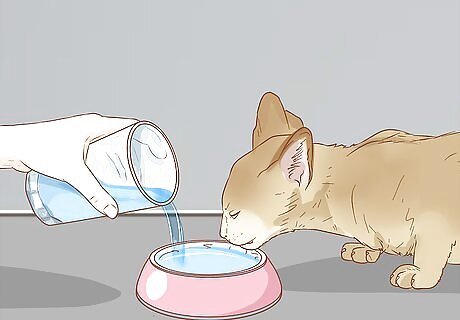
Keep your cat hydrated. Intestinal problems and diarrhea can dehydrate your cat very quickly. Make sure that you keep a water bowl available and accessible for your cat. Many cats actually prefer to drink moving water, so a fountain style bowl is a great option. You can tell if your cat is dehydrated by lightly pinching the folded skin behind their neck. In a dehydrated cat, the skin takes a while to return to its flat position or remains bunched up. You can also give your cat a 50-50 water and Pedialyte solution in their bowl. Talk to your vet first, though, to make sure that the combination won't mess up your cat's electrolytes. Be aware that dehydration can hit senior cats particularly hard. Don’t be surprised if your vet suggests an IV if your older cat gets dehydrated.

Perform any food changes gradually. Your vet might suggest some dietary changes for your cat, or you may take the initiative on your own. You can put your cat on a bland ground beef and rice diet by gradually switching out their meals over time. Quick dietary changes can make intestinal problems worse, while also making your cat more stressed. You should not keep your cat on a home cooked long-term bland diet, as it is not nutritionally complete. Talk to your vet about recommendations for how long you should keep your cat on a specialized meal program. It is possible that your vet will ask you to withhold food from your cat for up to one day. You can give your cat water during this period, but the temporary food stoppage is intended to allow your cat’s digestive system to “reset.” Your vet may also recommend a modified diet if they think that a food intolerance is causing your cat’s bloody stools.

Avoid giving your cat problematic foods. Some foods naturally irritate a cat’s digestive system. Try not to give your cat dairy products, no matter how much they seem to like them. Milk, yogurt, or cheese can result in severe gas or other intestinal problems. If these problems are severe enough, then your cat can create bloody stools.
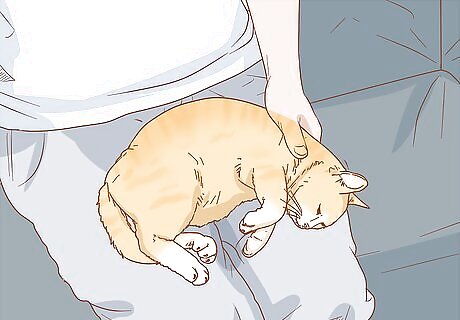
Keep your cat’s stress levels low. Colitis occurs when your cat’s intestines are irritated and inflamed. If your cat is stressed, they are more likely to suffer from colitis. To keep your cat calm, try to minimize any major changes in routine, such as moving or new additions to the household. Wait to introduce another cat or dog into your home until your present cat feels better.

Consider natural remedies. After getting approval from your regular vet, you might want to talk to a holistic vet about giving your cat natural supplements in order to improve their digestive health. Slippery elm extract can add fiber to your cat’s diet. Peppermint can minimize the presence of diarrhea and irritation. As with any other medication, follow all dosing guidelines closely. If you give your cat a supplement, make sure to talk with your vet about any potential warnings or side effects. For example, slippery elm can cause abortions in some animals and may also trigger an allergic reaction.
Health Observations
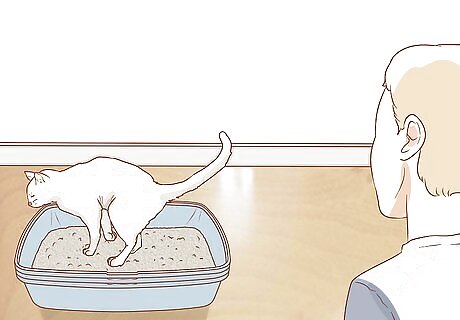
Watch your cat closely. Your cat’s everyday behaviors may give an indication as to whether they are feeling better or worse. Pay close attention to their eating and drinking habits as your cat may stop eating entirely if suffering from digestive issues. Acting overly hungry and gorging can be another sign of problems. Reach out to your vet if your cat seems to lack energy as well. Try to watch your cat use the litterbox to observe any signs of stress as they pass stools. If your cat appears to strain or is shaking, or if they make repeated trips to the litterbox without producing any stools or urine, then that can be a sign of a problem.
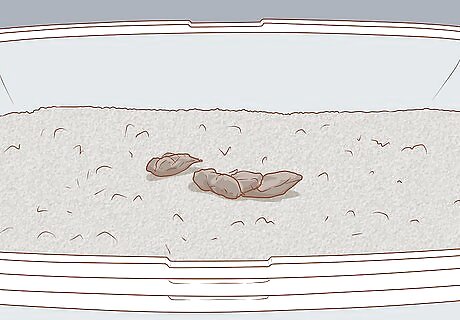
Know what normal stool looks like. An adult cat should produce stools on an average of once a day. Their stools should be 2–3 inches (5.1–7.6 cm) long and about .5 inches (1.3 cm) wide. They should be brown in appearance, or sometimes as light as a tan. The odor can be noticeable, but should not be lingering or too strong.

Know how to identify different types of blood in stool. There are many types of blood that can be present in your cat’s stool and they all indicate different things in the body. Blood that appears red or pink can mean that the problem originated in the lower intestine or anal region. If the blood appears black or brown, then the problem likely exists in the small intestine and may be more problematic as a result.

Pay attention to the consistency of the stool. Your cat’s stools should be fairly firm in appearance. You should be able to pick up the stools with a scooper without them running through the gaps. When the colon is not operating properly, then water mixes with feces and creates stool that is loose and resembles diarrhea. On the other hand, rock hard stools can mean that the digestive system is not properly lubricated and your cat may be dehydrated.
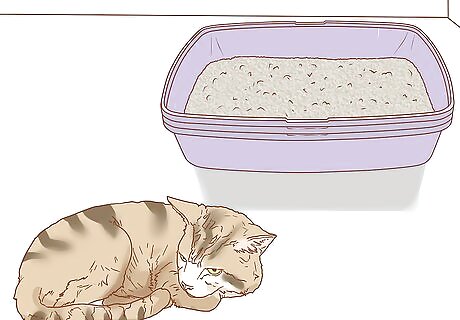
Be patient during the recovery period. It is possible that your cat may take a while to recover from bloody stools, especially if they indicate an underlying digestive problem. Your cat may even need to spend part of their recovery period at the vet under observation. Just try to follow the vet’s instructions and this should speed up the recovery.



















Comments
0 comment